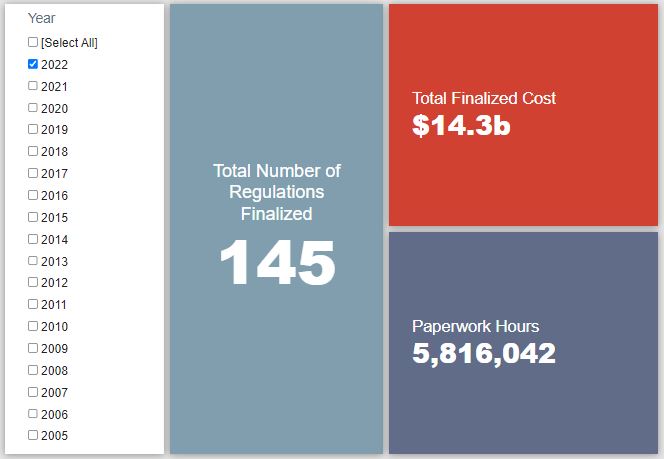Week in Regulation
August 15, 2022
Medicare Rule Highlights Slight Week
Coming on the heels of a blazing start, the second week of August saw a noticeable cooldown. With only five rulemakings that included some measurable economic impact estimates, there was not much to report on from the annals of the Federal Register. An otherwise routine Medicare payment rule from the Department of Health & Human Services (HHS) provided the majority of the week’s action. Across all rulemakings, agencies published $309.3 million in total net costs and added 1.3 million annual paperwork burden hours.
REGULATORY TOPLINES
- Proposed Rules: 58
- Final Rules: 43
- 2022 Total Pages: 49,898
- 2022 Final Rule Costs: $14.3 billion
- 2022 Proposed Rule Costs: $87 billion
NOTABLE REGULATORY ACTIONS
The most significant rulemaking of the week was the rule from HHS regarding “Medicare Program; Hospital Inpatient Prospective Payment Systems for Acute Care Hospitals and the Long-Term Care Hospital Prospective Payment System and Policy Changes and Fiscal Year 2023 Rates….” As with most annual Medicare and Medicaid payment rules, this 720-page rule largely focuses on how and why funding gets distributed to covered providers under said programs. It does, however, include some substantial changes to relevant pieces of paperwork. In this case, HHS expects the paperwork burden for covered providers to increase by roughly 1.2 million hours annually, with $62.2 million in commensurate administrative costs.
TRACKING THE ADMINISTRATIONS
As we have already seen from executive orders and memos, the Biden Administration will surely provide plenty of contrasts with the Trump Administration on the regulatory front. And while there is a general expectation that the current administration will seek to broadly restore Obama-esque regulatory actions, there will also be areas where it charts its own course. Since the AAF RegRodeo data extend back to 2005, it is possible to provide weekly updates on how the top-level trends of President Biden’s regulatory record track with those of his two most recent predecessors. The following table provides the cumulative totals of final rules containing some quantified economic impact from each administration through this point in their respective terms.
![]()
The Medicare rule discussed above was the lone final rule of the week, and thus accounted for the totality of the shifts in the Biden Administration’s cost and paperwork tallies. In an interesting bout of symmetry, the most notable development across the other two administrations comes in – what else? – a Medicare payment rule from the Trump Administration. Per the regulatory analysis in that rule, changes made to relevant provisions produced annual paperwork reductions of 2.9 million hours (or $195 million in monetized costs). Due primarily to this action’s reductions, the Trump Administration regulatory net-cost total as of the first couple weeks of August 2018 descended into merely the tens of millions of dollars.
THIS WEEK’S REGULATORY PICTURE
This week, the Federal Energy Regulatory Commission (FERC) wants the truth.
 Source: “Power pylons at sunset” by Matthew Henry
Source: “Power pylons at sunset” by Matthew Henry
On August 12, FERC published a proposed “Duty of Candor” rule in the Federal Register. As its name implies, the action would require “all entities communicating with the Commission or other specified organizations related to a matter subject to the jurisdiction of the Commission submit accurate and factual information and not submit false or misleading information or omit material information.”
According to FERC, the agency has a “patchwork” of requirements for certain communications with commissioners and staff but lacks a broad mandate requiring honesty in all communications. For example, one part of its existing regulations prohibits false statements made by entities who have sought or obtained electric market-based rate authority. A second, separate section of its regulatory code requires a “person appearing before the Commission or the presiding officer must conform to the standards of ethical conduct required of practitioners before the Courts of the United States.”
In justifying the new proposal, FERC argues it is incumbent that it makes decisions based on accurate information and the broad requirement covering all communications will help ensure it can do its job. It also provides a safe harbor provision, where the agency shields entities from any violations of the broad standard if they exercise due diligence regarding the accuracy of submissions.
The proposal was not unanimously supported by FERC’s commissioners, however. Commissioner James Danly dissented in advancing the proposal. He argued that “[t]he powers we propose to grant ourselves in this rulemaking are so broad and the standards so vague that, if finalized, it would be a simple proposition for the Commission to ‘find’ that any factually untrue statement, regardless of context, violates the duty of candor, exposing the speaker to sanctions. And rather than establish guard rails or explicit limits to our powers, we instead say ‘just trust us.’”
TOTAL BURDENS
Since January 1, the federal government has published $101.4 billion in total net costs (with $14.3 billion in new costs from finalized rules) and 81.9 million hours of net annual paperwork burden increases (with 5.8 million hours in increases from final rules).












